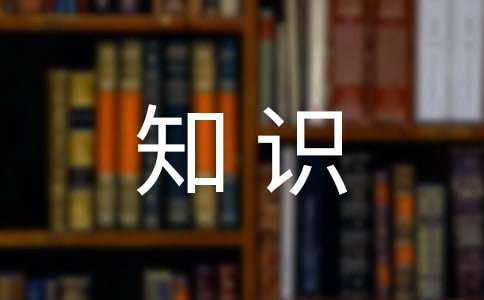初二英语重点语法知识点归纳
我们从小学开始学习英语,到了初中就开始正式系统学习英语语法知识,那么初二的学生需要掌握哪些语法知识呢?下面是百分网小编为大家整理的初二英语必备的知识点,希望对大家有用!

初二英语语法知识
1.由that引导,由于that没有任何意义,也不充当任何句子成分。因此that在非正式文体中可以省略。这类宾语从句通常表达一种陈述意义。
e.g.He told me (that) he would go to Wuhan.
Tom says (that) he must study hard.
She told me (that) she was a student.
(1)如果由and连接两个并列的宾语从句时,第二个that则不能省略。
e.g.She said she liked English very much and that she didn’t like math at all.
(2)常接that引导的宾语从句的谓语动词有:believe, expect, explain, feel, hear, hope, imagine, prefer, promise, report, say, see, tell, think, understand, warn, wish等。
2.由连接代词或连接副词who, whose, what, which, when, where, how, why引导,含有“谁、什么、哪个、什么时候、什么地方、怎样、为什么”等特殊疑问意义。
e.g.Do you know who they’re talking about?
Can you tell me what they’re looking for?
I don’t know where she has gone.
I wonder how she can find us.
She didn’t tell me where her hometown was.
3.由从属连词whether和if引导,含有“是否,能否,对否,有否”等一般疑问意义。
e.g.She asked me if I could help her.
Jim wanted to know whether I had taken his English book.
Please tell me whether you can come or not.
在这类宾语从句中要注意两点:
(1)if引导宾语从句和状语从句的区别
if引导宾语从句时意为“是否”,从句中该用什么时态就应用什么时态。
if引导条件状语从句时意为“假如”,从句中应用一般现在时代替一般将来时。
e.g.She wanted to know if you were a teacher.
I don’t know if the letter is yours.
They’ll go boating if it is fine tomorrow.
I’ll give it to her if she comes next week.
(2)if引导宾语从句时多数情况下可以与whether互换,但如果要突出“究竟是……还是不……”这层意思时,通常用whether,并在后面的加上“or not”,即一般要选择whether构成whether…or not的结构。
e.g.Please find out whether the money is his or not.
Let me know whether you can come or not.
I want to know whether you can help me or not.
初二英语基础知识
1) leave的用法
1.“leave+地点”表示“离开某地”。例如:
When did you leave Shanghai?
你什么时候离开上海的?
2.“leave for+地点”表示“动身去某地”。例如:
Next Friday, Alice is leaving for London.
下周五,爱丽斯要去伦敦了。
3.“leave+地点+for+地点”表示“离开某地去某地”。
例如:
Why are you leaving Shanghai for Beijing?
你为什么要离开上海去北京?
2) 情态动词should“应该”学会使用
should作为情态动词用?常常表示意外、惊奇、不能理解等?有“竟会”的意思例如::How should I know? 我怎么知道?
Why should you be so late today?
你今天为什么来得这么晚?
should有时表示应当做或发生的事?例如:
We should help each other.我们应当互相帮助。
我们在使用时要注意以下几点
1. 用于表示“应该”或“不应该”的概念。此时常指长辈教导或责备晚辈。例如:
You should be here with clean hands. 你应该把手洗干净了再来。
2. 用于提出意见劝导别人。例如:
You should go to the doctor if you feel ill. 如果你感觉不舒服?你最好去看医生。
3. 用于表示可能性。should的这一用法是考试中常常出现的考点之一。例如:
We should arrive by supper time. 我们在晚饭前就能到了。
She should be here any moment. 她随时都可能来。
3) What...? 与 Which...?
1. what 与 which 都是疑问代词,都可以指人或事物。但是what仅用来询问职业。如:
What is your father? 你父亲是干什么的?
该句相当于: What does your father do?
What is your father's job?
Which 指代的是特定范围内的某一个人。如:
Which is Peter? 哪个是皮特?
---The boy behind Mary. 玛丽背后的那个男孩。
2. What...?是泛指?所指的事物没有范围的限制,而 Which...?是特指,所指的事物有范围的限制。如:
What color do you like best? 所有颜色
你最喜爱什么颜色?
Which color do you like best, blue, green or yellow? 有特定的范围
你最喜爱哪一种颜色?
3. what 与 which 后都可以接单、复数名词和不可数名词。如:
Which pictures are from China?
哪些图片来自中国?
初二英语必备知识点
1)will/shall+动词原形 shall用于第一人称,常被will 所代替。will 在陈述句中用于各人称,在征求意见时常用于第二人称。will not=won't shall not=shan't例如:
Which paragraph shall I read first? 我先读哪一段呢?
Will you be at home at seven this evening? 今晚七点回家好吗?
2) be going to +不定式,表示将来。
a. 主语的意图,即将做某事。例如:What are you going to do tomorrow? 明天打算作什么呢?
b. 计划,安排要发生的事。例如:The play is going to be produced next month。这出戏下月开播。
c. 有迹象要发生的事。例如:Look at the dark clouds, there is going to be a storm. 看那乌云,快要下雨了。
3) be +不定式表将来,按计划或正式安排将发生的事。例如:
We are to discuss the report next Saturday.我们下星期六讨论这份报告。
4) be about to +不定式,意为马上做某事。例如:
He is about to leave for Beijing. 他马上要去北京。
注意:be about to do 不能与tomorrow, next week 等表示明确将来时的时间状语连用。
Notice:be to和be going to
be to 表示客观安排或受人指示而做某事,be going to 表示主观的打算或计划。例如:
I am to play football tomorrow afternoon. 明天下午我去踢球。(客观安排)
I'm going to play football tomorrow afternoon. 明天下午我想去踢球。(主观安排)
5)现在进行时表将来时
下列动词的现在进行时表示将来时
go.come.fly.leave.start.begin.finish.end.arrive and so on.
she is leaving for Wuhan tomorrow.
6)一般现在时表将来
1)下列动词come, go, arrive, leave, start, begin, return的`一般现在时可以表示将来,主要用来表示在时间上已确定或安排好的事情。例如:
The train leaves at six tomorrow morning. 火车明天上午六点开。
When does the bus star? It stars in ten minutes. 汽车什么时候开?十分钟后。
2)以here, there等开始的倒装句,表示动作正在进行。
几种时态
1,一般现在时
2,一般过去时
3,一般将来时
4,现在进行时
还有几种词
1,名词
2,代词
3,形容词
4,动词
5,冠词
初一英语语法
1、名词
A)、名词的数
我们知道名词可以分为可数名词和不可数名词,而不可数名词它没有复数形式,但可数名词却有单数和复数之分,复数的构成如下:
一)在后面加s。如:fathers,books,Americans,Germans,apples,bananas
二)x,sh,ch,s,tch后加es。如:boxes,glasses,dresses,watches,wishes,faxes
三)1)以辅音字母加y结尾的变y为i再加es如:baby-babies,family-families,duty-duties,comedy-comedies,documentary-documentaries,story-stories
2)以元音字母加y结尾的直接加s。如:day-days,boy-boys,toy-toys,key-keys,ways
四)以o结尾加s(外来词)。如:radios,photos,但如是辅音加o的加es:如:tomatoes西红柿,potatoes马铃薯
五)以f或fe结尾的变f为v再加es(s)。如:knife-knives,wife-wives,half-halves,shelf-shelves,leaf-leaves,yourself-yourselves
六)单复数相同(不变的)有:fish,sheep,deer鹿子,Chinese,Japanese
七)一般只有复数,没有单数的有:people,pants,shorts,shoes,glasses,gloves,clothes,socks
八)单词形式不变,既可以是单数也可以是复数的有:police警察局,警察,class班,同学,family家,家庭成员
九)合成的复数一般只加主要名词,多数为后一个单词。如:action movie-action movies,pen pal-pen pals;但如果是由man或woman所组成的合成词的复数则同时为复数。如:man doctor-men doctors,woman teacher-women teachers
十)有的单复数意思不同。如:fish鱼fishes鱼的种类,paper纸papers报纸,卷子,论文,work工作works作品,工厂,glass玻璃glasses玻璃杯,眼镜,orange桔子水oranges橙子,light光线lights灯,people人peoples民族,time时间times时代,次数,chicken鸡肉chickens小鸡
十一)单个字母的复数可以有两种形式直接加s或’s。如:Is(I’s),Ks(K’s)。但如是缩略词则只加s。如:IDs,VCDs,SARs
十二)特殊形式的有:child-children,man-men,woman-women,foot-feet,mouse-mice,policeman-policemen,Englishman-Englishmen
B)名词的格
当我们要表示某人的什么东西或人时,我们就要使用所有格形式。构成如下:
一)单数在后面加’s。如:brother’s,Mike’s,teacher’s
二)复数以s结尾的直接在s后加’,如果不是以s结尾的与单数一样处理。如:Teachers’Day教师节,classmates’;Children’s Day六一节,Women’s Day三八节
三)由and并列的名词所有时,如果是共同所有同一人或物时,只加最后一个’s,但分别拥有时却分别按单数形式处理。如:Mike and Ben’s room迈克和本的房间(共住一间),Mike’s and Ben’s rooms迈克和本的房间(各自的房间)
2、代词
项目人称代词物主代词指示代词反身代词
人称主格宾格形容词名词性
第一人称单数I me my mine myself
复数we us our ours ourselves
第二人称单数you you your yours yourself
复数you you your yours yourselves
第三人称单数she her her hers herself
he him his his himself
it it its its this that itself
复数they them their theirs these thosethemselves
3、动词
A)第三人称单数
当动词是第三人称单数时,动词应该像名词的单数变动词那样加s,如下:
一)一般在词后加s。如:comes,spells,waits,talks,sees,dances,trains
二)在x,sh,ch,s,tch后加es。如:watches,washes,wishes,finishes
三)1)以辅音字母加y结尾的变y为i再加es。如:study-studies,hurry-hurries,try-tries
2)以元音字母加y结尾的直接加s。如:plays,says,stays,enjoys,buys
四)以o结尾加es。如:does,goes
五)特殊的有:are-is,have-has
B)现在分词
当我们说某人正在做什么事时,动词要使用分词形式,不能用原形,构成如下:
一)一般在后加ing。如:spell-spelling,sing-singing,see-seeing,train-training,play-playing,hurry-hurrying,watch-watching,go-going,do-doing
二)以不发音e的结尾的去掉e再加ing。如:dance-dancing,wake-waking,take-taking,practice-practicing,write-writing,have-having
三)以重读闭音节结尾且一个元音字母+一个辅音字母(注意除开字母组合如show–showing,draw-drawing)要双写最后的辅音字母再加ing。如:put-putting,run-running,get-getting,let-letting,begin-beginning
四)以ie结尾的变ie为y再加ing。如:tie-tying系die-dying死lie-lying位于
4、形容词的级
我们在对两个或以上的人或物进行对比时,则要使用比较或最高级形式。构成如下:
一)一般在词后加er或est(如果是以e结尾则直接加r或st)。如:greater-greatest,shorter–shortest,taller–tallest,longer–longest,nicer-nicest,larger-largest
二)以重读闭音节结尾且1个元音字母+1个辅音字母(字母组合除外,如few-fewer fewest)结尾的双写结尾的辅音再加er/est。如:big-bigger biggest,red-redder reddest,hot-hotter hottest
三)以辅音字母+y结尾的变y为i加er/est。如:happy-happier happiest,sorry-sorrier sorriest,friendly-friendlier friendliest(more friendly mostfriendly),busy-busier busiest,easy-easier easiest
四)特殊情况:(两好多坏,一少老远)
good/well-better best many/much-more most bad/ill–worse worst
little-lessleast old-older/elder oldest/eldest far-farther/further farthest/furthest
5、数词(基变序,有规则;一、二、三,自己背;五、八、九、十二;其它后接th;y结尾,变为i,eth跟上去。)first,second,third;fifth,eighth,ninth,twelfth;seventh,tenth,thirteenth,hundredth;twenty-twentieth,forty-fortieth,ninety-ninetieth
今天的内容就介绍到这里了。
【初二英语重点语法知识点归纳】相关文章:
初二英语重点短语归纳11-30
初二英语知识点归纳6篇08-05
中考英语语法重难点知识点归纳11-17
高考重点理科知识点归纳10-01
中考英语重点短语归纳11-26
小升初语文重点知识点归纳12-19
高二英语重点短语归纳11-15
七年级英语下册重点短语和语法归纳总结03-10
生物高考重点知识点归纳分享11-08
小升初语文重点知识点归纳人教版12-19